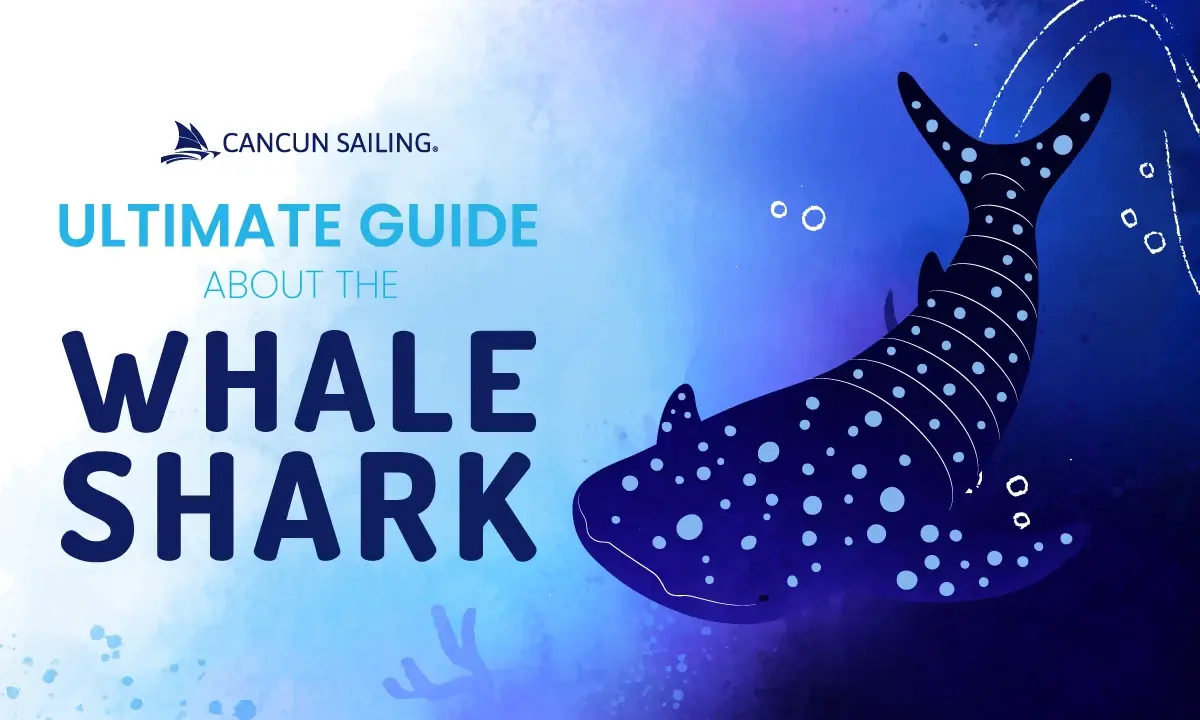4 min read
Subaquatic Cancun: Exploring the aquatic wonders of the Caribbean
Cancun is Mexico's tourist destination par excellence and is well known for its paradisiacal beaches of fine white sand, crystal clear waters, and an...
5 min read
Diana Gonzalez
:
May 31, 2024 10:06:36 AM

The whale shark is considered the second-largest cartilaginous fish species in the world! Learn this and many other curious facts about the whale shark in this post, where we will find out about the migration season, feeding and safety measures to take if you are interested in meeting these creatures face to face.
Whale sharks reach at least 12 meters in length. Imposing, aren't they? But don't let their enormous size fool you, despite being one of the largest sea creatures in the world, they are too docile, and their favorite food is plankton, FIU! 😮💨, a relief for us and thousands of other creatures in the ocean.
It is well known that the largest agglomeration of whale sharks is in the Mexican coasts of the Caribbean Sea, so if you venture to visit Cancun during the months of May through July, you have a greater chance of spotting these beautiful species.

Whale sharks have enormous jaws, which allow them to ingest their food through a process called filtration. Very similar to the feeding process of basking fish and manta rays 🤔. Once they open their jaws completely, their mouth absorbs EVERYTHING around them, and after closing their mouths, they expel the water through their gills.
In general, whale sharks tend to forage at the surface and the main food of whale sharks are: plankton, krill, baby crabs, anchovies, jellyfish, sardines, nekton and squid.
Did you know? Whale sharks are capable of consuming up to 117 kg of food per day.
And... you may be wondering how do they process all that food😲 well, well, the whale shark has up to 350 rows of small teeth, as well as 10 pads that serve as filters for their food, which allows them to consume what their gigantic bodies demand of them per day.
Generally, whale sharks are found in warm and temperate waters, therefore, it is very common that during their migration process almost all encounters with whale sharks are recorded in most of the coastal nations of tropical seas around the world.
A fact you should know is that: whale sharks can withstand temperatures as low as -10 degrees Celsius 🥶 (for very short periods), however, they like to swim at temperatures of 20 to 31 degrees Celsius.

Did you know that whale sharks are really long-lived? That's right, they can live from 70 to 135 years! Of course, aggressive species (such as killer whales), fishing, noise pollution, collisions with boats and human irresponsibility, as well as global warming 😢 can also interfere with their longevity.
Many people, through this experience, have learned to respect and raise awareness about the incredible impact that we as humans cause in the habitats of the largest fish in the world, even this activity is carried out with expert guides, who are responsible for informing each of the tour guests to keep distance and respect these animals.
The scientific name of the whale shark is Rhincodon typus, and, although it is a type of fish, the whale shark receives its peculiar name due to the spiracles around its eyes, and, like whales, it eats the smallest thing in the ocean. The shark part is due to the cartilaginous structure of its skin, as well as its pectoral fins.

Although they swim extremely slowly, whale sharks can swim distances of up to 13,000 km in 37 months at a speed of 3.9 km/hr and can descend to more than 1,700 meters underwater.
They often allow divers to swim close to them, and are extremely peaceful.
They usually live near some coasts and river mouths, and are also found in Mexico (La Paz), Australia, New Zealand, the Philippines, Honduras, Belize and Tanzania. With the exception of the Mediterranean Sea, they can be found in other tropical oceans with warm waters.
From Cancun, it is possible to see whale sharks in the islands located north of Cancun, such as Isla Mujeres, Isla Contoy and Isla Holbox.
At Cancun Sailing, you can find tours dedicated to whale shark watching, where you can experience how impressive it is to swim with the biggest fish in the ocean.
Come visit us and enjoy the Wale Shark Experience!
The whale shark migration season off the coasts of Quintana Roo and nearby islands is from late May to mid-September.
There are many general recommendations for swimming with whale sharks, however, we want to share with you the most important ones so you can take your experience to the next level.

Img source: https://www.pinterest.com.mx/pin/155303887779534843/
Although they are usually very peaceful, it is important that you respect their space, so that they do not feel threatened or intimidated. Remember that it is you who are in their habitat.
Even when this is a guided activity, it is recommended that it be done by people with sufficient knowledge in swimming, who at the same time keep calm during the activity.
During the activity, you may need to be in good physical condition, therefore, we do not recommend this activity to people with hypertension problems, people over 65 years old, pregnant women, or children under 10 years old.
It doesn't matter if you don't plan to go down to swim with these immense creatures, being in a boat or ship, the recommended distance is 10 meters away and up to 23 to 30 meters when in motion, to avoid colliding with them or disturbing them.
It is not every day that we have the opportunity to meet and swim with this type of species, that is why we recommend following the instructions of your guide, they know the area very well, and we are sure that they care about you having an unforgettable experience.
Generally, this type of tour is done in small groups, so it is important that you do not get separated from the group for any reason.
You may be an experienced swimmer, but it doesn't mean you shouldn't take some precautions for this activity.
Chemicals are one of the main reasons why the habitats of marine species become scarce or die, such is the case of white coral, which helps to generate new species of tiny life, and in turn, to protect the oceans against hurricanes and other natural disasters.
In addition, whale sharks are not accustomed to exposure to these chemicals, which can trigger irreversible health problems in these and other marine species.
You can learn more about this and other information at the following NGO's: WWF and PADI Proyect Aware.
We also recommend you to read the following post, for more information about the migratory adventure of the whale shark.
Have you already swam with whale sharks? Tell us about your experience in the comments, we are excited to read about this kind of experiences.

4 min read
Cancun is Mexico's tourist destination par excellence and is well known for its paradisiacal beaches of fine white sand, crystal clear waters, and an...

Summer is coming to Cancun, and temperatures are rising above 35° C. Too hot? Here are the best underwater activities to cool off.